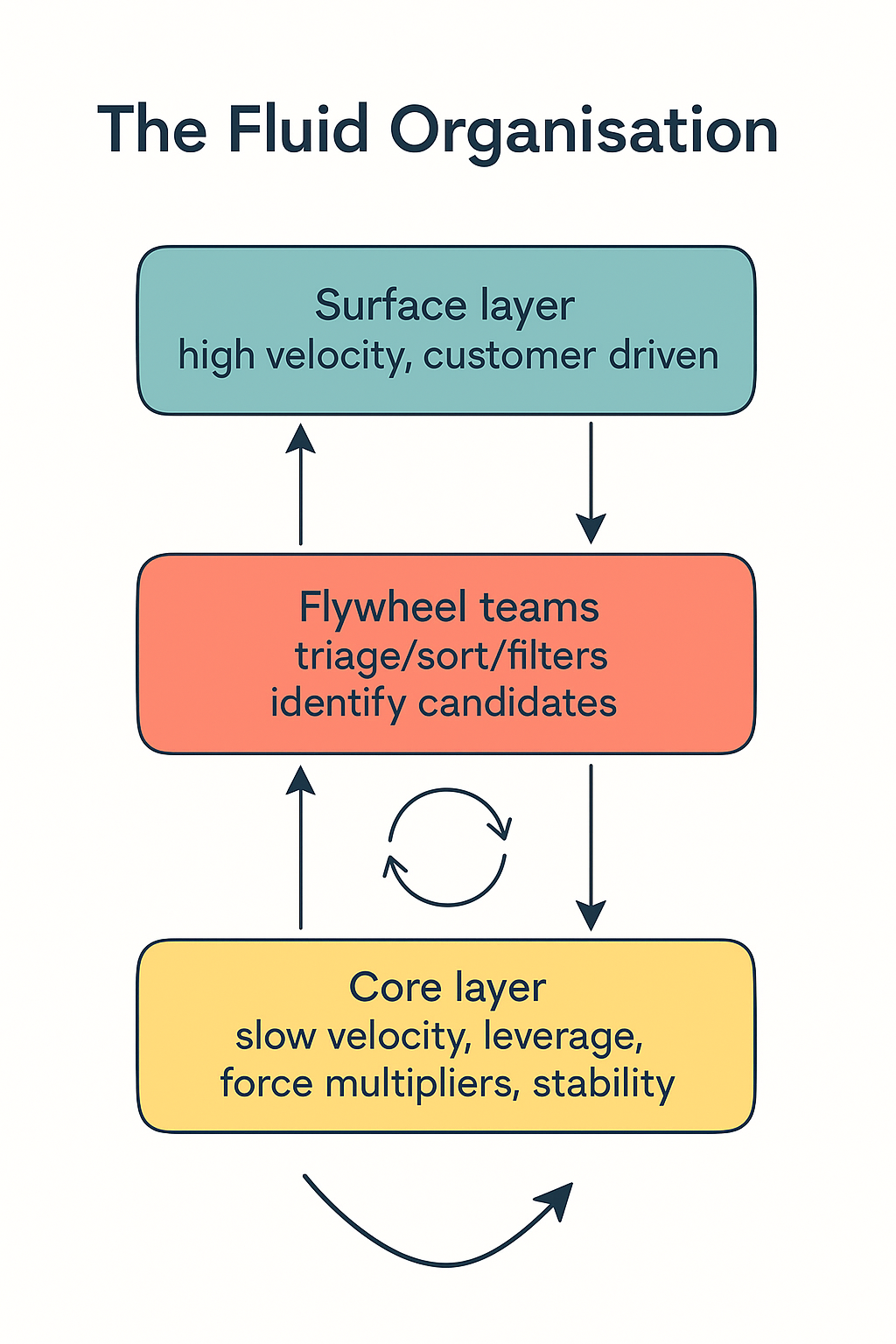Fluid Org: Five Flywheel Patterns That Restore Motion Without Chaos

Introduction: A System Needs Motion, Not Uniformity
The Fluid Organisation Model is a model where teams operate at different velocities across three layers: Surface (fast-moving), Core (stable and reusable), and the Flywheel in between as a dynamic interface that absorbs signal, reduces entropy, and enables reuse without enforcing alignment by cadence.

Inspired by the continuously variable transmission (CVT) mechanism, the Flywheel layer is elastic: the number of teams may grow or shrink as needed depending on organisational tension, entropy, and domain pressure.: the number of teams may grow or shrink as needed depending on organisational tension, entropy, and domain pressure.
If you are new to the model, the white paper is available here.
In the Fluid Organisation, the Flywheel plays a critical role: it absorbs signal, filters chaos, and enables convergence across layers. But the Flywheel is not a single team or method. It is a pattern, a set of roles, rhythms, and interfaces that vary depending on scale, maturity, and pressure.
In this article, we explore five Flywheel patterns observed in high-functioning systems. Each supports flow without enforcing uniform speed, and each enables coherence through adaptive structure.
Understanding the Metrics
Each of the following patterns is evaluated through the lens of three core metrics defined in the Fluid Organisation white paper. If you are unfamiliar with these metrics, Org Re, TQS, and Entropic Pressure, we provide you wit a quick summary:
- TQS (Transduction Quality Score): Calculated as (Conversion Rate × Adoption Rate × Interface Maturity Score) ÷ Time to Standardisation. This reflects how effectively Flywheel activity turns signal into reusable capability.
- Org Re (Organisational Reynolds Number): Calculated as (Delivery Velocity × Team Count) ÷ Interface Maturity. This captures friction from delivery outpacing structural clarity.
- Entropic Pressure: Calculated as (Interface Change Rate × Delivery Velocity) ÷ Interface Maturity. This measures strain from volatile, high-throughput motion against current interface readiness.
These metrics help contextualise the impact of each Flywheel behaviour.
Pattern 1: Shadow Integrators
Embed temporarily inside delivery teams to capture emerging reuse.
One can confuse this pattern with Pattern Shepherds, but the two differ in orientation. Shadow Integrators embed inside delivery teams to distil reusable logic at the source, while Pattern Shepherds operate across teams to shape reusable structure from emerging trends.
A rotating subset of platform engineers or Staff+ ICs join product teams temporarily, working inside sprints but not owning backlog. They observe, prototype, and extract reusable logic. After one or two cycles, they exit the team and leave behind a paved path.
- Good for: uncovering pain before formalising solutions
- Signs of success: TQS increases, Entropic Pressure drops as reuse replaces local hacks
- Why the metrics improve: TQS improves because Flywheel participants capture signal directly and co-design reusable outputs. Entropic Pressure declines as redundant patterns are avoided and discovery is transformed earlier.
For example, a Staff Engineer joins a checkout squad for two sprints. They observe repeat authentication logic used in three services. A shared login module is extracted and published with minimal disruption. It is adopted by four teams within a month. TQS improves as the module is highly adopted (Adoption Rate 0.8), quickly packaged (Time to Standardisation 2 sprints), and published with clear documentation (Maturity Score 4). Entropic Pressure also declines as the number of redundant patterns drops from three to zero.
Shadow Integrators are field agents. They operate close to raw delivery and harvest useful signal early.
Pattern 2: Signal Clinics
Live triage sessions that structure demand before it reaches Core teams.
In this context, a clinic refers to a scheduled, focused session where teams bring requests or issues for real-time triage with Flywheel engineers. These sessions differ from general support hours: they are proactive, signal-focused forums that encourage live conversation and decision-making. Participants are expected to come prepared with relevant context, and the Flywheel team captures insights for follow-up and reuse design. Rather than logging tickets asynchronously, stakeholders explain their needs live, enabling richer triage, immediate clarification, and better signal quality.
Weekly or fortnightly Flywheel clinics are run for Core or Platform-bound asks. Instead of asynchronous tickets, stakeholders walk in with context. The Flywheel team triages live: decline, buffer, or convert into experimental enablement.
- Good for: surfacing chaotic demand and filtering intent
- Signs of success: Signal latency shortens, and Org Re stabilises after initial spikes
- Why the metrics improve: Entropic Pressure declines as unmanaged requests are redirected or repackaged. Org Re stabilises when unplanned demand is buffered before reaching Core systems. TQS benefits from improved framing and signal context.
For example, a weekly enablement clinic filters ad hoc platform requests. One undocumented access control workaround is formalised into a templated extension. Two squads adopt it within the same sprint. TQS improves from 0.3 to 0.65, based on high conversion and adoption rate (0.6), maturity score of 3.5, and time to standardisation of 2 weeks. Interface Maturity improves as ownership, guidance, and fallback are clarified. Entropic Pressure drops from 42 to 18 due to a reduction in interface churn and better triage.
Pattern 3: Pattern Shepherds
Translate experimentation across teams into stable, reusable assets.
While Shadow Integrators work from within delivery teams to identify emerging structure, Pattern Shepherds operate externally to shape and formalise it across domains. They translate scattered experimentation into cohesive system assets, often acting at a broader scope than their embedded counterparts.
We intentionally chose the term "Shepherd" because it suggests more than delivery oversight. It evokes care, stewardship, and guided transition from chaos to structure. Rather than controlling delivery or owning systems, a Pattern Shepherd cultivates coherence where it naturally starts to form. The role is observational, translational, and constructive, turning emerging usage into enduring structure. This pattern overlaps with Developer Experience (DevEx) responsibilities, helping to reduce friction across teams by shaping reusable structures and improving clarity without imposing control.
The engineer or product person who collects successful patterns from the edge and prepares them for downstream adoption. They manage transition, not backlog.
- Good for: translating fast-paced discovery into stable inputs
- Signs of success: Absorption Ratio increases, fewer re-implementations
- Why the metrics improve: TQS improves because signal is translated with better accuracy and intent. Org Re declines as structured interfaces replace duplicate efforts.
For example, a lead engineer observes how three squads independently create feature flag logic. They consolidate it into a reusable library and promote it via the frontend guild. Within two sprints, adoption occurs across three teams. TQS improves from 0.5 to 0.85, based on a high adoption rate (0.75), strong interface maturity (score of 4), and a short time to standardisation (2 weeks). Org Re drops from 60 to 28 as duplicated deployment paths are eliminated and delivery converges on shared structure.
Pattern Shepherds are system framers. They stabilise emerging convergence into formalised, reusable infrastructure.
Pattern Shepherds generalise when Shadow Integrators distil.
Pattern 4: Reuse Jam
A themed hack cycle where teams are challenged to build only with existing tools.
Instead of building new things, a hack cycle is scoped around reuse. Teams are challenged to solve with existing primitives. The Flywheel team prepares golden paths, playgrounds, and light coaching to help remove perceived barriers to reuse.
- Good for: unblocking reuse friction and revealing where reuse is not real
- Signs of success: TQS recalibration, rising interface maturity scores
- Why the metrics improve: TQS improves as teams interact with interfaces under real conditions. Interface Maturity increases when documentation gaps and usability issues are addressed. Entropic Pressure lowers as teams shift from building to reusing.
For example, during a reuse-focused hack day, a team is challenged to integrate with an internal payments module. They raise onboarding issues, contribute improvements, and publish an updated quick start. Within days, two squads adopt it. TQS rises from 0.6 to 0.9, driven by a 0.8 adoption rate, maturity score of 4.5, and time to standardisation of one sprint. Entropic Pressure drops from 38 to 12 as reuse shortens delivery effort.
Pattern 5: Flow Cells
Temporary Flywheel groups formed to stabilise high-entropy domains.
When entropy clusters around a specific domain (e.g. compliance, observability, onboarding), a semi-autonomous Flywheel group forms to manage transduction in that zone. They co-own signals, extract reusable capability, and phase themselves out once stability is reached.
- Good for: high-friction zones where platform cannot generalise yet
- Signs of success: Org Re drops steadily in the domain, Entropic Pressure becomes predictable
- Why the metrics improve: Org Re declines within the targeted domain as interface maturity improves. TQS increases when domain-specific signals are owned by transduction-focused teams. Entropic Pressure becomes manageable as boundaries stabilise.
For example, an observability enablement cell forms in response to divergent logging formats across backend squads. They coordinate to produce a unified schema and build a dashboard library. Adoption across five services boosts TQS from 0.4 to 0.88, based on a 0.7 adoption rate, maturity score of 4.7, and standardisation within one quarter. Org Re drops from 72 to 28 as duplicated logic is replaced by a common interface. Entropic Pressure falls from 44 to 15 as demand becomes predictable and maintainable.
Conclusion: The Flywheel Is Not a Team, It Is a Pattern
Flywheels are not a department. They are a recurring shape that emerges wherever signal must be absorbed and reused without breaking flow. These five patterns show how adaptation, not alignment, enables systems to scale.
Each pattern affects one or more metrics (Org Re, TQS, and Entropic Pressure) and can be tracked accordingly to evaluate system health.
You do not need permission to try one. You need tension, curiosity, and a way to observe change. Start with the pattern that best reflects your team’s current friction, and observe how the metrics respond.
Appendix: Flywheel Pattern Cards (GoF-style)
Pattern: Shadow Integrators
- Real-world equivalents: Integration teams, solution architects, adoption squads
- Intent: Capture emerging patterns from active delivery
- Context: When reuse has not yet emerged and platform friction is high
- Structure: Rotate a Staff+ IC into squads for two sprints
- Forces: Balance trust, speed, and scope discovery
- Consequences: Increases TQS, reduces entropy but may not scale long-term
Pattern: Signal Clinics
- Real-world equivalents: Developer support desks, intake PMs, platform-facing solution engineers
- Intent: Triage signal upstream and avoid passive ticket queues
- Context: High inbound demand or platform-team overload
- Structure: Weekly open clinics run by Flywheel teams
- Forces: Requires prep and consistent facilitation
- Consequences: Reduces Org Re and Entropic Pressure while improving framing
Pattern: Pattern Shepherds
- Real-world equivalents: DevEx strategists, Staff+ enablement engineers, DevRel with system shaping remit
- Intent: Translate exploration into platform-ready inputs
- Context: Emergent convergence across multiple squads
- Structure: One person dedicated to interface evolution
- Forces: Needs trust and visibility; risks over-centralisation
- Consequences: Raises TQS and stabilises interface adoption
Pattern: Reuse Jam
- Real-world equivalents: Internal hackathons, reuse sprints, enablement challenges
- Intent: Promote reuse by inverting innovation pressure
- Context: Poor reuse habits or immature Flywheel adoption
- Structure: Themed internal hack event with reuse goals
- Forces: May expose immaturity; needs enablement support
- Consequences: Increases TQS and maturity and lowers Entropic Pressure
Pattern: Flow Cells
- Real-world equivalents: Domain-specific platform pods, compliance or observability enablement squads
- Intent: Address entropy in a high-friction domain
- Context: Domain-level divergence too complex for central platform
- Structure: Temporary Flywheel sub-team with domain focus
- Forces: Must eventually dissolve; risks siloing
- Consequences: Lowers Org Re and Entropic Pressure in target area





Member discussion